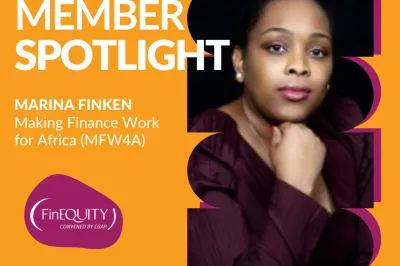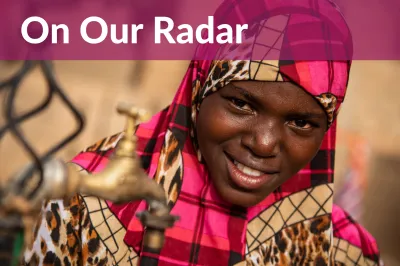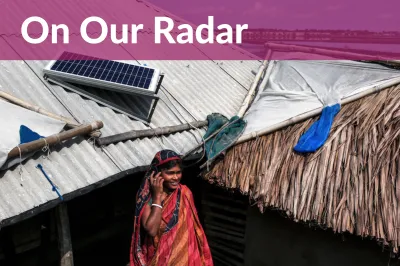Making Measurement Count: A Focus on Impact Pathways for Women’s Financial Inclusion

FinEquity’s new learning agenda, developed by drawing on engagement with our membership base and deep-dive consultations with leading research and programmatic stakeholders, is organized around three main learning themes: Gender Transformative Solutions, Digitally-Enabled Financial Inclusion, and Impact Pathways. This is the fourth post in our series on FinEquity’s new learning themes, launched in 2020.
In this post, FinEquity’s new Thematic Lead for Impact Pathways (IP), Jennifer Ferreri, shares an overview of the theme, introducing the work plan for the coming year and highlighting how members can engage during the year.
Moving the conversation from access/usage and generalized impact
Over the past 10 years, the financial inclusion sector has spent a lot of time working to reduce a 9-percentage point gap in women’s account ownership in financial services vis-à-vis men. The financial inclusion sector has been driven by the promise that women’s usage of financial services produces significant impacts, such as increased income and assets, improved resiliency to withstand shocks, and greater agency as well as decision-making power. Since we are unable to measure the impact of services that are not being used, many programs have had to address the need to improve access and usage of financial products as precursors to examining other economic or empowerment benefits. However, as we all know, higher access and usage of financial services by women do not guarantee impact.
While existing evidence demonstrates how well-designed financial products increase resilience and reduce the risk for low-income households, positive impacts for low-income individuals do not necessarily translate to equivalent impact for all women. This is especially true in diverse country contexts where gender norms vary and mobile access is lower. The current COVID-19 emergency has further underscored the need to build the evidence base around which products and services can strengthen resilience and/or support empowerment for female customers in times of crisis. With this in mind, FinEquity’s Impact Pathways learning theme for 2021 has selected two sub-themes – Resilience and Women’s Economic Empowerment – looking to move the narrative from one of generalized impact to a more nuanced one that considers different female customer segments. This also reflects the recent updates to CGAP’s Theory of Change for Financial Services impact highlighted in the graphic below.

The Basis for Impact Pathways - What we know
Despite a continued global gender gap of 9 percentage points since 2011 in account ownership, there has been notable progress in the total number of women being brought into the formal financial system. We also know that there are many barriers to women’s access and use of products that prevent them from employing them in expected ways. This mismatch means that it is often difficult for researchers to accurately capture the impact of financial products on women. Since women are not a monolithic customer segment, researchers have acknowledged the need to explore the impact of certain products or combination of products for multiple female segments.
Much of the impact evidence to date documents how specific financial products support building resilience for low-income households. In studies examining women’s economic empowerment, there is an awareness that gendered social norms influence how women interact with products and services, often outlining why female clients did not capture the same benefits as males receiving the same treatment. Below is a small selection of impact evidence that provides an overview of how specific financial products contribute to various aspects of well-being, especially for women:
- Person-to-person payments via digital channels have improved the resilience of low-income households in Kenya, Rwanda, and Tanzania to respond to negative shocks by both expanding who can provide support funds to them and by lowering the cost of receiving them.
- While microcredit for women-owned firms in Bangladesh, did not lead to immediate increases in business profits, cumulative borrowing over time equated to reductions in extreme poverty.
- In Chile, evidence showed that many women use credit and savings products as a type of self-insurance and that by eliminating the costs associated with savings accounts, women can reduce debt burdens and mitigate economic shocks better.
- In Nepal, researchers found high uptake of no-fee accounts by unbanked female-led households living in slums did not correspond to asset increases but did result in higher spending on education, diet diversification and ceremonies/festivals.
- Several studies in Sri Lanka and Uganda showed how reduced decision-making power and control over money within households can limit or negate the impact of business credit or grants for women entrepreneurs compared to male counterparts.
- In India and Niger, women increased their bargaining power within households by receiving wages or social cash transfers directly to digital payment accounts they control, which had positive impacts on other empowerment metrics like labor force participation and power over household spending, respectively.
What are our priorities within the Impact Pathways theme and how are we addressing them?
We have broken down the learning theme into three sub-themes with associated learning questions that arose during consultations with members and discussions during the FinEquity2020 meeting. We also anticipate a lot of collaboration with FinEquity’s other two learning themes Gender Transformative Solutions and Digitally Enabled Financial Inclusion (DEFI).
The first sub-theme seeks to build our understanding of how and when specific financial products and services improve resilience for different female customer segments. We will share existing frameworks, definitions, and theories of change being used by members to map improved resilience among different women segments through DGroups dialogues, literature reviews, and case studies. These case studies will draw attention to impact evidence, as well as how members are thinking about resilience.
Be on the lookout in March for a DGroups call to share how you are defining and incorporating resilience - we want to hear from you and profile your work!
The next sub-theme will look at incorporating Women’s Economic Empowerment (WEE) metrics into our work. Within this theme, we plan to work on two levels – building consensus on definitions and metrics for those already using these measurements in women’s financial inclusion initiatives and identifying entry points for members interested in WEE, but who are uncertain about where to begin. We hope to work with our members to collaborate on the standardization of frameworks and indicators for women’s economic empowerment in financial inclusion using FinEquity’s existing knowledge product Measuring Women’s Economic Empowerment in Financial Inclusion mapping tool as a starting point. We also plan to spotlight how distinct types of organizations (Financial Service Providers, I/NGOs, Fintechs, Donors) have integrated WEE and the specific domains of focus through interviews or webinars.
The third sub-theme looks more closely at gender analysis. Last year, FinEquity’s publication Making the Case for Gender Data in Financial Inclusion looked at how we can use sex-disaggregated data to support women’s financial inclusion. This year, we would like to support the adoption of gender analysis in two ways: (1) by providing examples of how selected financial service providers or fintech members incorporate gender analysis into their work, looking at design, customer segmentation, and disaggregation of data; and (2) by identifying ways to support strong integration of gender analysis in the design of financial inclusion research and initiatives.
We will begin by reviewing existing gender tools/approaches for research, program implementation, and impact measurement. We will then use a combination of DGroups dialogues, case studies, and heuristic guides, to engage with members on best practices in gender analysis, paying special attention to how they may be incorporated by diverse types of institutions.
How can members actively participate in our Impact Pathways learning theme?
I am excited to work with FinEquity and look forward to this year’s learning journey as we build evidence and understanding of Impact Pathways in Financial Inclusion. Over the next few months, we will be inviting you to share your work, participate in case studies, and collaborate with your peers on one or more of the above learning sub-themes and questions. I will also be drawing examples from each of the regions where you work. We will also be hosting quarterly conversations, which will provide an opportunity for people interested in Impact Pathways to learn more about our collective progress, offer input on upcoming activities, and connect on the work plan. Please stay tuned!


